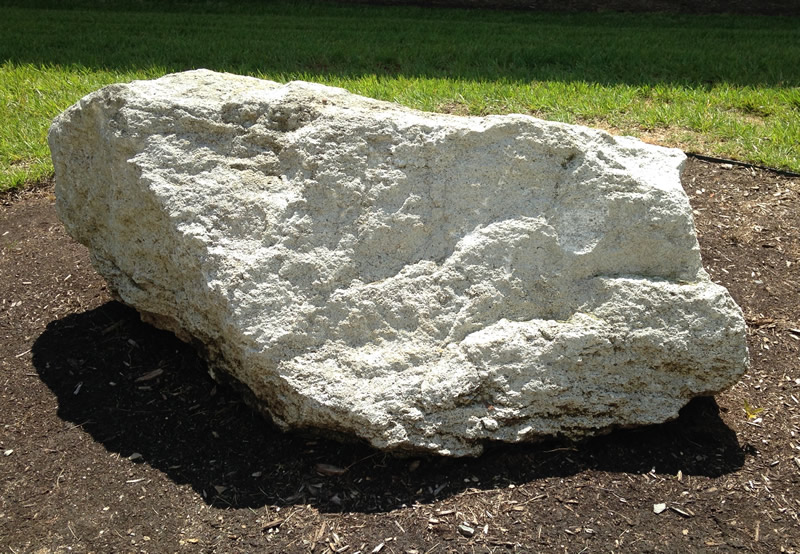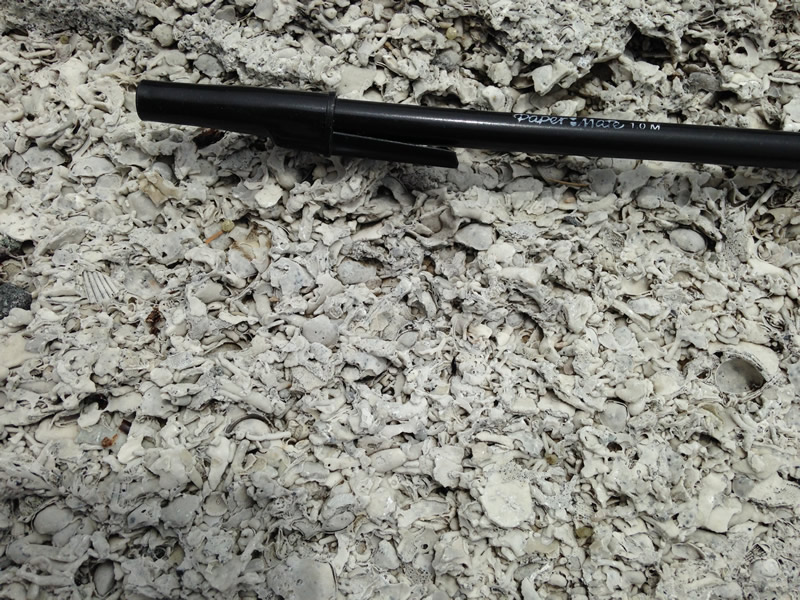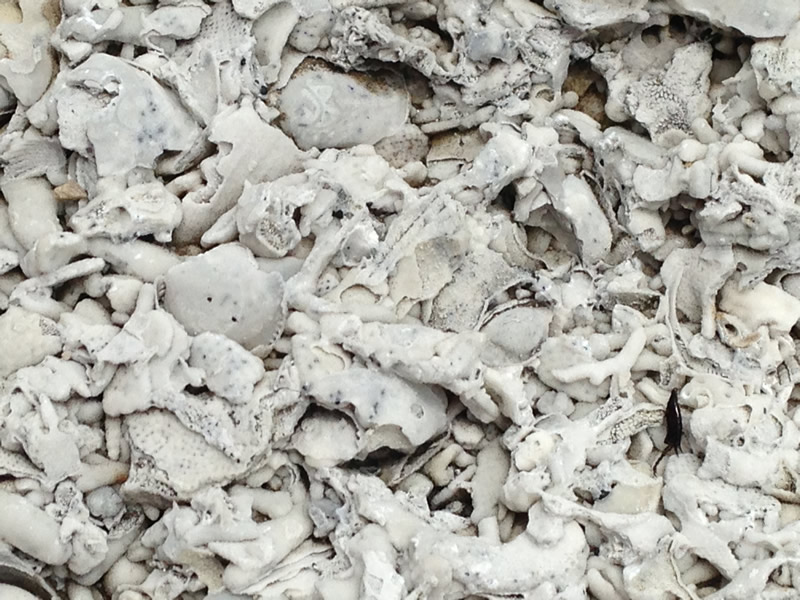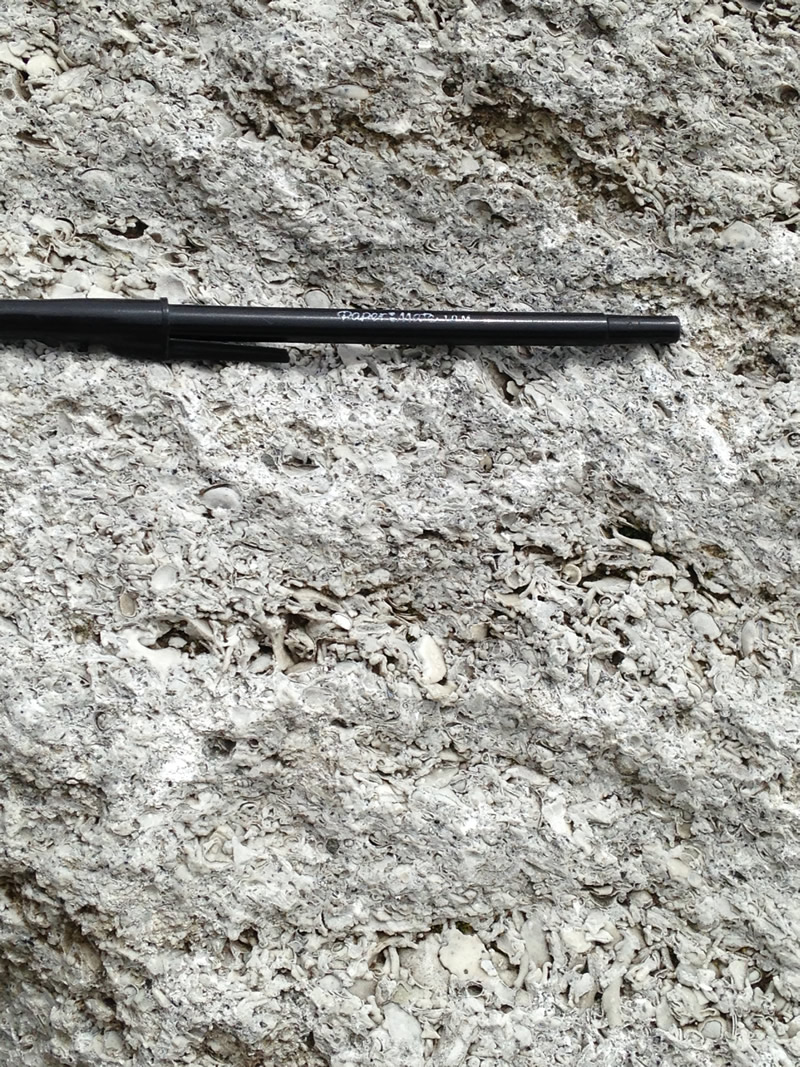Happy Holidays!
Wake Tech is closed December 24 through January 4 for winter break and will reopen January 5. Prospective students can still apply for enrollment online during the break, and continuing students can register for Spring semester classes, which start January 7.
Outdoor Geology Lab Tour: Onslow Limestone

Rock type
Sedimentary
Description
A white rock composed of broken fossil pieces that are laid out in layers. The fossils are generally loosely cemented together with white calcite cement, but there are places where the cement is more extensive. The fossil pieces are all roughly gravel-size – about the size of the tip of a finger or smaller.

Figure 1: The Onslow limestone boulder on Scott Northern Wake Campus

Figure 2: The Onslow limestone boulder on Southern Wake Campus
Unique features
The main features to notice in this rock are the broken fossils arranged in layers. The fossils that make up this rock include shell and skeletal material from most groups of invertebrate marine life, including scallops, clams, snails, corals and sponges. Shark teeth may also be found in this rock. Most of the fossils are unidentifiable because of the extent to which they are broken.

Figure 3: The surface of the Onslow limestone, with a black ballpoint pen for scale. Notice how the fossils are arranged in layers and how some sections seem to have more holes than others. These "hole-filled sections" have less cement holding the fossils together than is found in the more solid-looking sections.

Figure 4: In this detail image, you can see the size of the fossil pieces. Each is about the size of the tip of a finger or smaller. You may also notice many different shapes, reflecting the different organisms that made each fossil.

Figure 5: In this detail view of the limestone, you can really see how broken and worn down the different fossils are. You can also see how many different shapes there are, each of which corresponds to a different fossil organism.
How did it form?
Sedimentary rocks like limestone form when rock-making debris (in this case, fossils) accumulate and become cemented together to form a solid rock. Based on the sizes of the fossils and the fact that they are broken instead of whole, these fossils were probably transported a long distance by flowing water and then were deposited in an environment with energetic water, such as on a beach with crashing waves.
How would a geologist figure out how it formed using rock characteristics?
Laboratory experiments have shown that, when sedimentary particles, such as the fossils in this limestone, are transported by flowing water, the sediment rolls along the bottom, bumps into other pieces of sediment and gets banged up by the transport. All of this movement and bumping causes the edges of the fossils to break off or wear down over time. Therefore, the amount of wearing and breaking on the edges of the fossils can give us a rough estimate of the length of time they spent being moved by water before being deposited to form the rock. Since the edges of the fossils in the Onslow limestone are broken and worn down, this suggests that they experienced extensive transport before deposition to give them time to become as broken and worn as they are.
Other laboratory experiments have shown that the amount of movement and energy a body of water has determines which sizes of sediment it can carry and which sizes it deposits out because they are too heavy to be carried. These experiments have demonstrated that, the faster the water flows, the more energy it has, and, therefore, the larger the sediment the water will move. The slower the water flows, the lower its energy; low-energy water can move only the smallest of sedimentary particles, so the larger sizes of sediment deposit out of low-energy water. The fossils in the Onslow limestone are predominantly gravel-sized. Gravel is a large grain size that requires water with high energy to be moved, and gravel will deposit out any time the energy level drops. Additionally, there are no fossils that are smaller than gravel, which suggests that the water must have been highly energetic when the fossils were deposited; if the water had lower energy during deposition, smaller sedimentary particles would have been deposited as well.
The fact that the fossils are arranged in layers in the rock suggests that not all of the fossils were deposited at the same time. There are two potential hypotheses that could explain what we observe in this rock:
- Each layer may represent a different deposition event, such as a storm event that picked up lots of shells, transported them (which broke and wore down the edges) and deposited them once the storm died down. Every layer would have been from a unique storm event. If this hypothesis is correct, we should see distinct layers with obvious separations, as there likely would have been lengthy breaks between storms.
- Alternatively, the location where this rock formed could have been a place where sediment of this size was routinely brought and deposited, such as on a beach with crashing waves. The constant energetic wave action would wear down and break the fossils, and every wave would have the potential to deposit a new layer of fossils over the old ones. In this case, the separations between layers should not be very obvious.

Figure 6: Another image of the layers of worn and broken fossils in the limestone. Do you think it formed as successive storm deposits or during continual slow accumulation at the beach?
2023 Footer Column 1
2023 Footer Column 2
- Wake Tech Mobile App
- Help & Support
2023 Footer Column 3
- Connect
919-866-5000
Contact Us | Terms of Use | Privacy Policy | Campus Policies | Site Map







